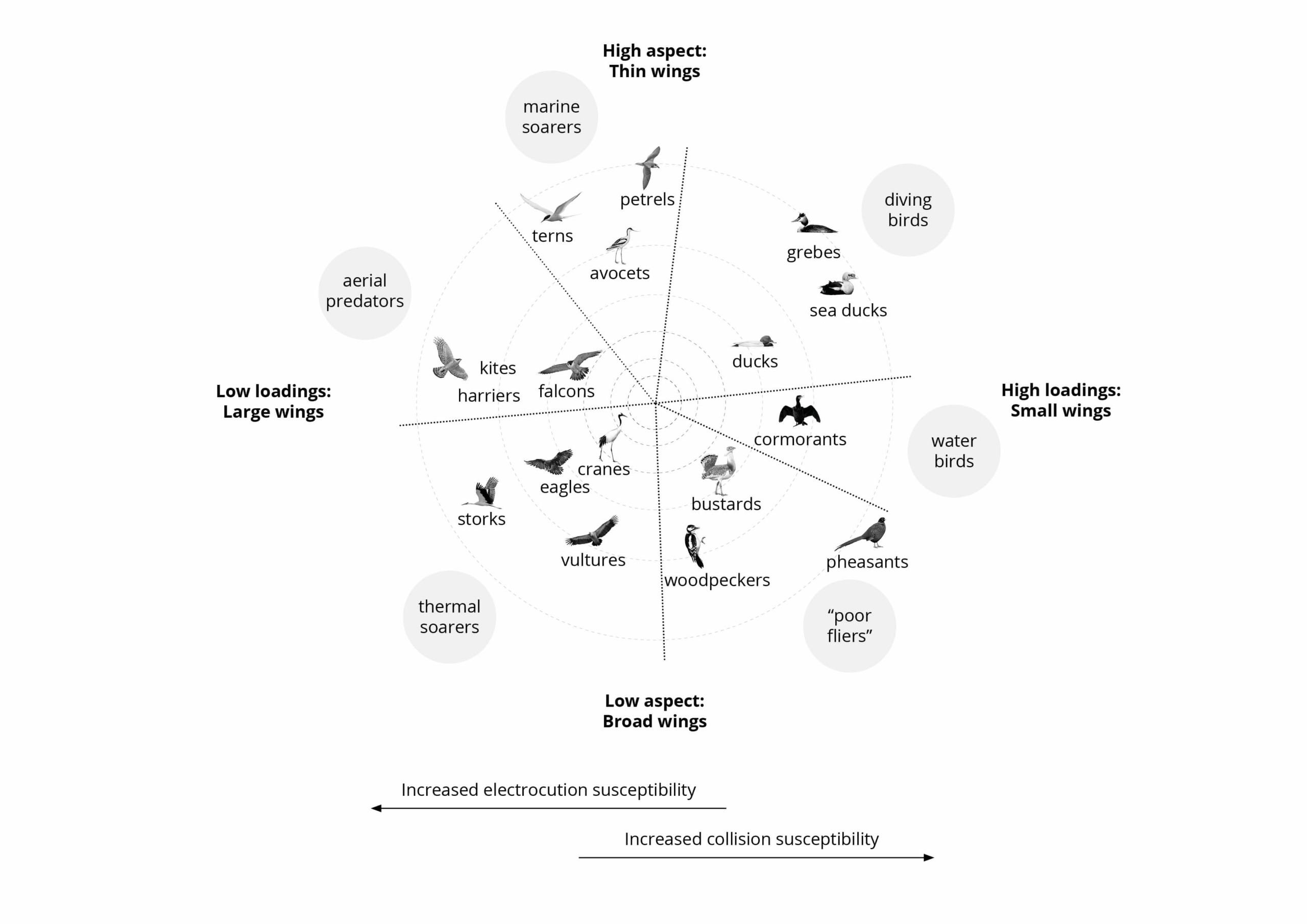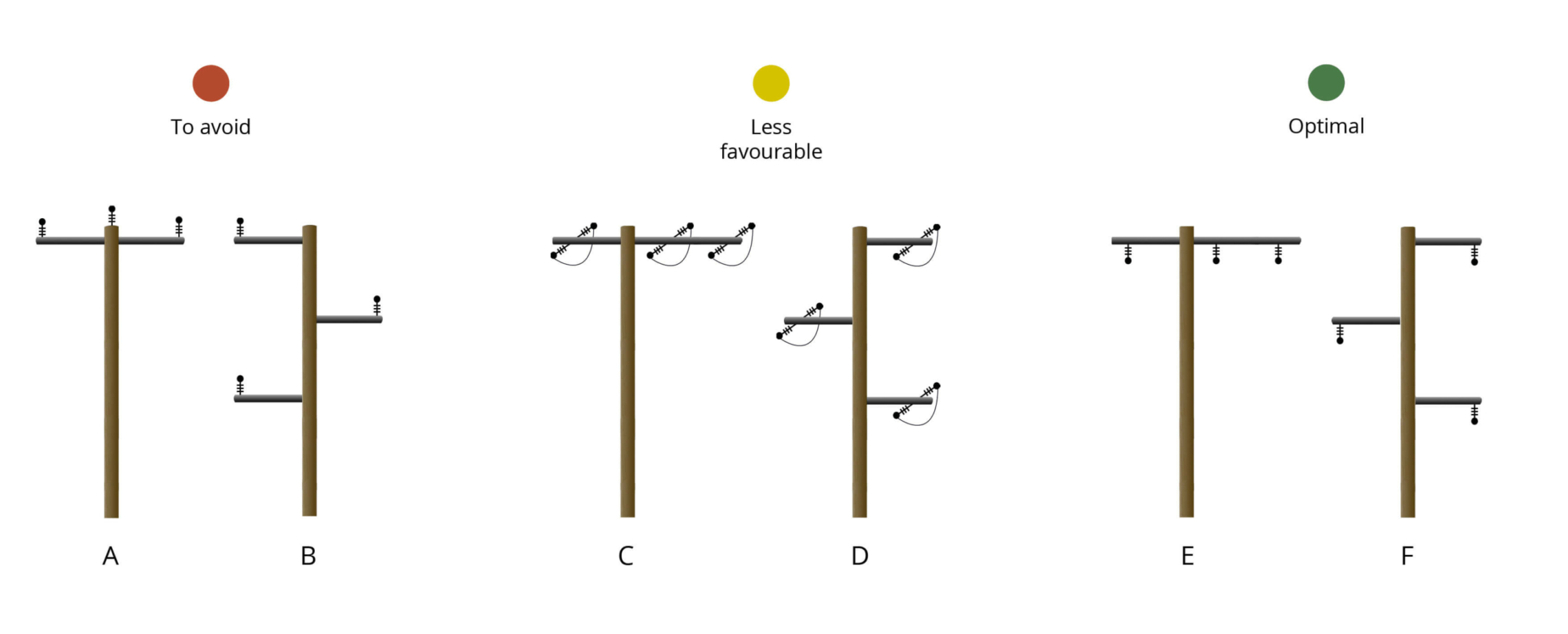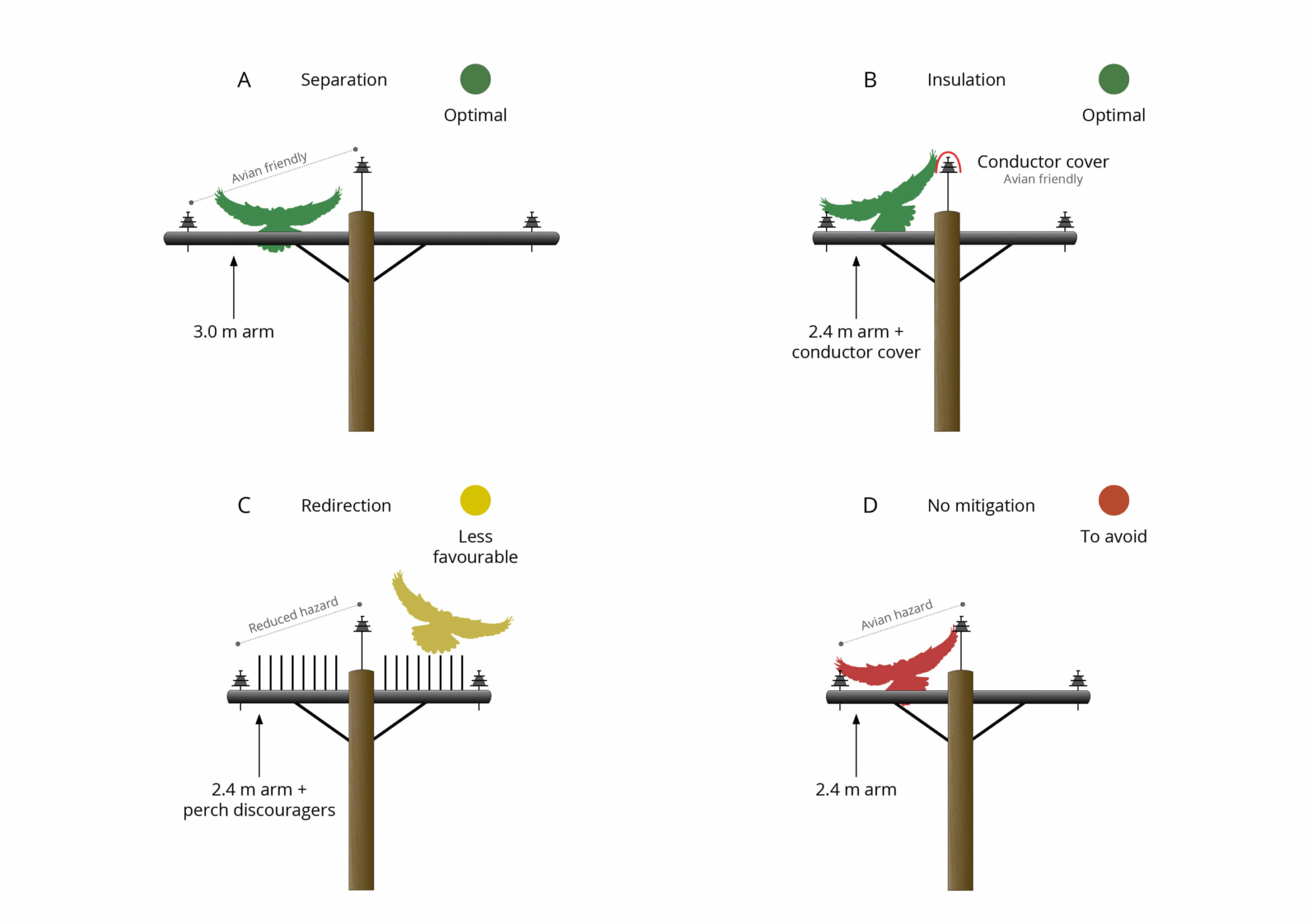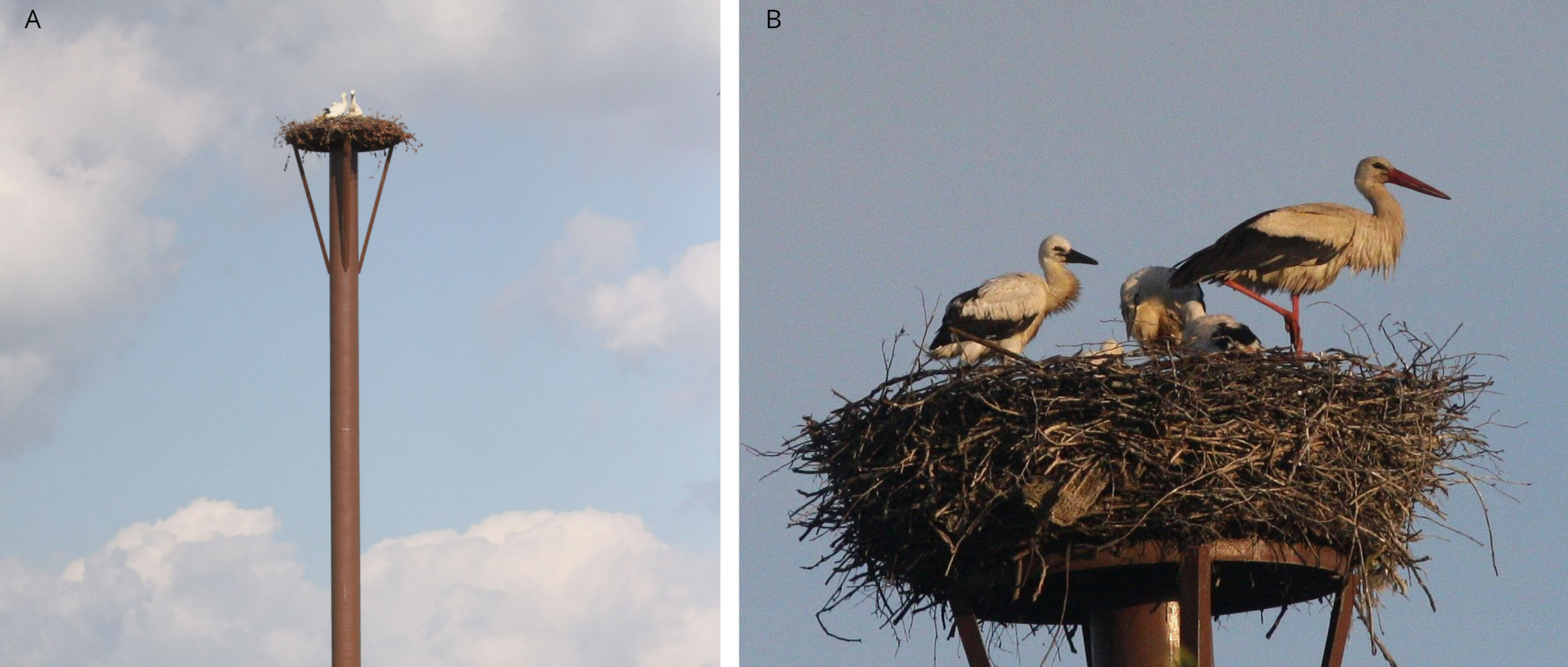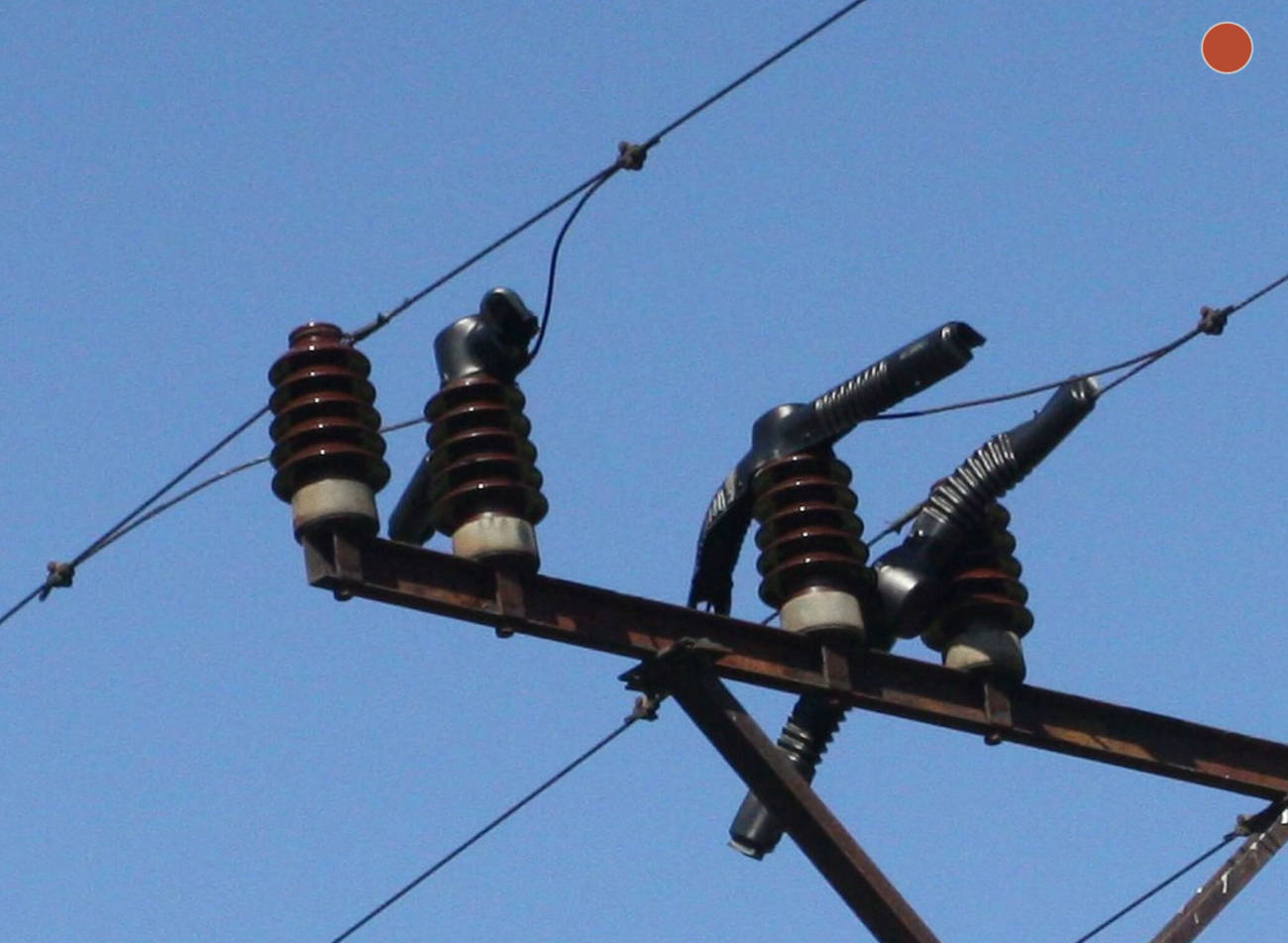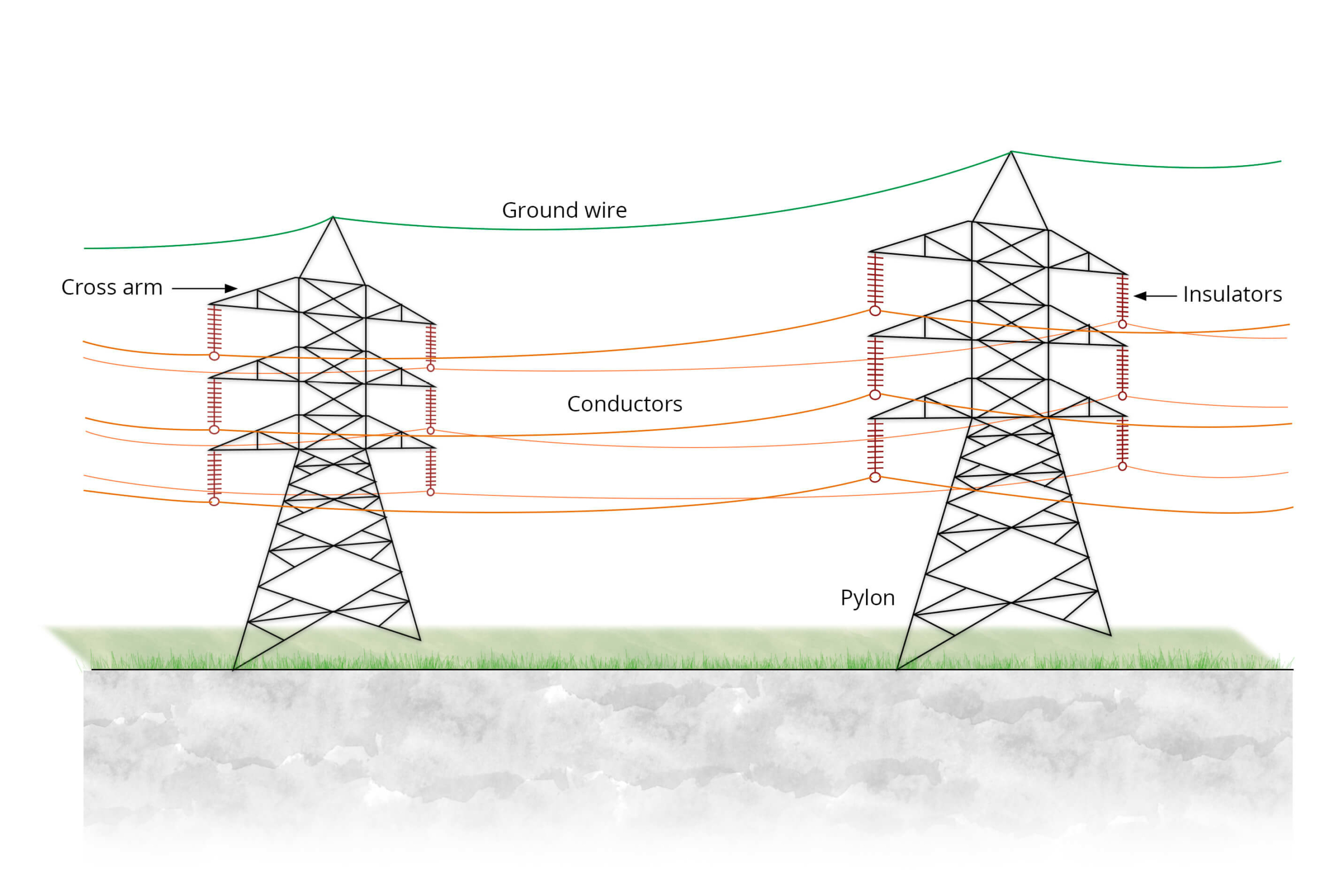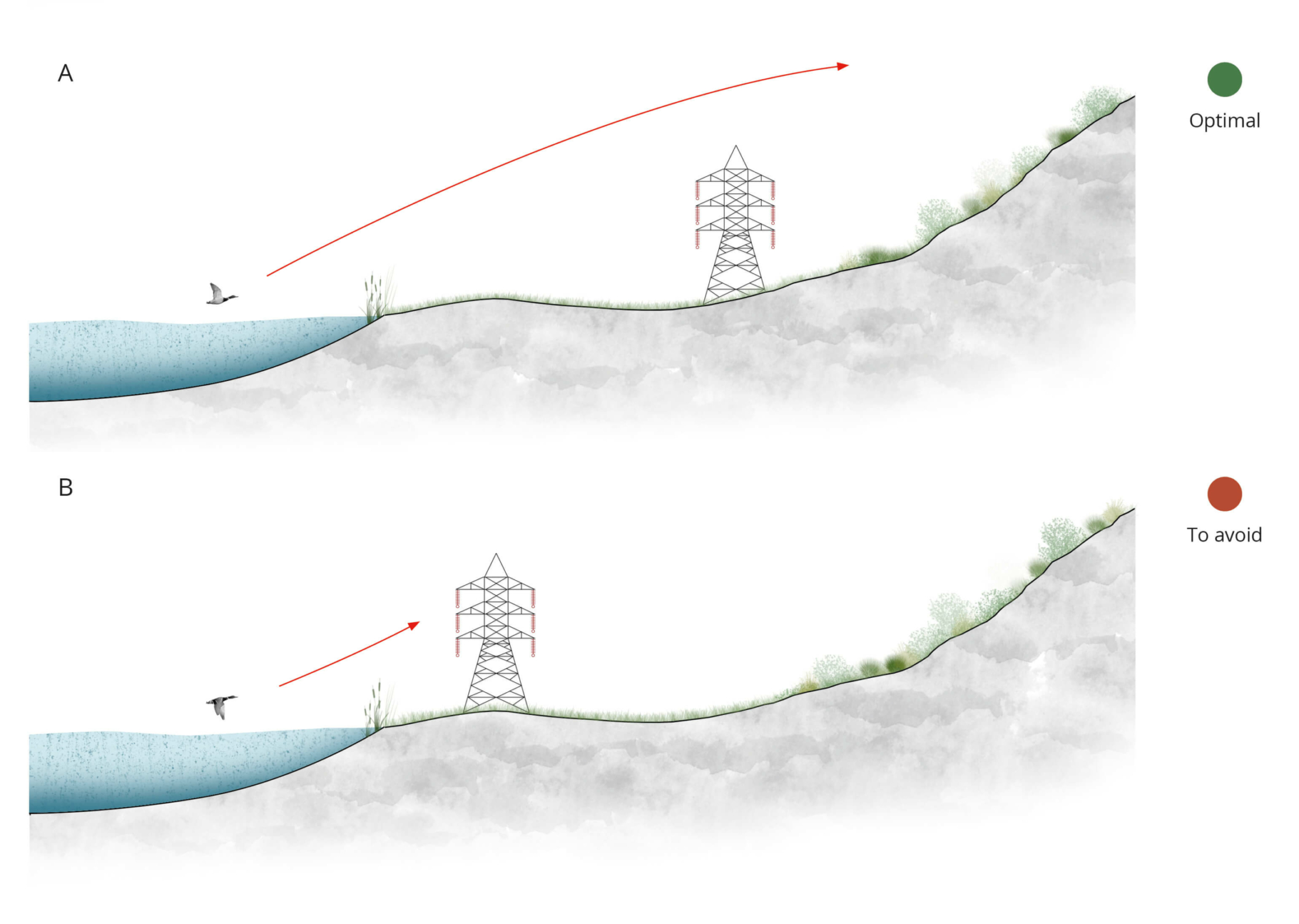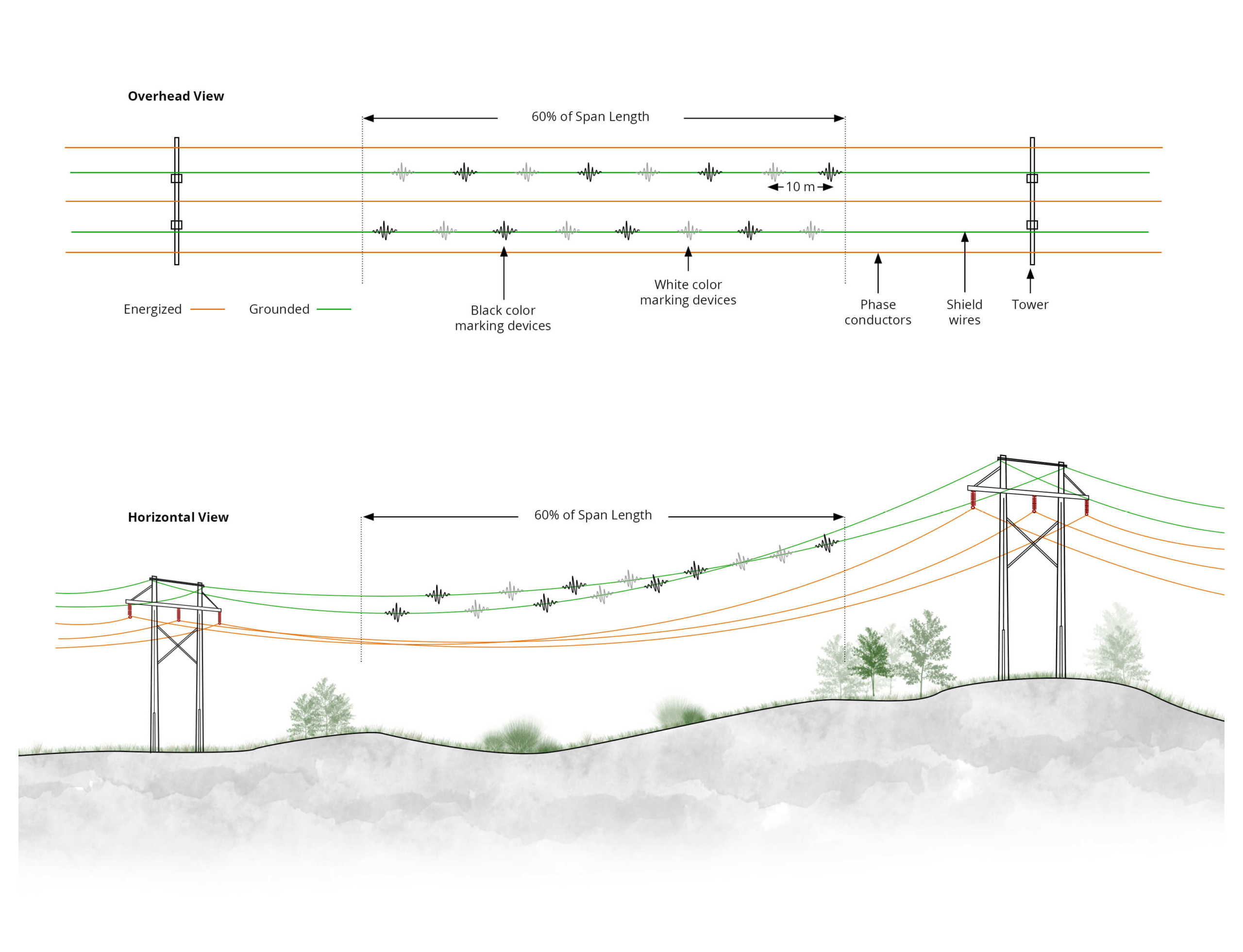RATIONALE. Measures to reduce risks caused by powerlines
Powerlines cause millions of bird deaths over the world due to collisions and electrocution (Prinsen et al., 2011a; Loss et al., 2014; Guil & Pérez-García, 2022), affecting also other taxa although mainly in other parts of the world (Martín et al., 2022, and references therein). Furthermore, there are other impacts, such as barrier effect, ignition of wild fires, and perturbances caused by noise and electromagnetic fields (EMF) (D’Amico et al., 2018, Guil et al., 2018; Martín et al., 2022).
EMF impacts on wildlife and humas are understudied (Cucurachi et al., 2013), but several studies have reported behavioural and ecological effects in several species, including inhibition of plant growth due to oxidative stress, reduction in reproductive success in birds and disruption of environmental cues such as orientation for several taxa, like insects, birds, bats, and others (Balmori, 2005; Burda et al., 2009; Cucurachi et al., 2013, Vaitkuviené and Dagys, 2014; D’Amico et al., 2018).
Powerlines are increasing significantly due to the current change in energy model (IEA, 2020; Martín et al., 2022) and, therefore, implementing available solutions it is key to mitigate these impacts. Solutions described in this section are focused on mitigating bird mortality due to electrocution and collision. It is important to highlight that these events cause also economic impacts for electricity companies due to maintenance needs, as well as inconvenience for users due to power outbreaks (Martín et al., 2022).
Powerlines have a significant visual impact on landscapes and transform natural habitats, creating a barrier effect for some animal species. On the other hand, they can also provide benefits for biodiversity, such as providing new habitats and ecological corridors (see Section 5.7.1 – Verges and other green areas). Powerlines can pose a variety of risks to wildlife if they are not designed appropriately. Three main risks for flying fauna are identified:
- risk of electrocution
- risk of collision with cables and supporting structures
- risk of trapping birds in hollow concrete power poles
- loss of habitat quality.
Once installed and operational, retrofitting modifications to powerlines can be expensive, however small modifications can be easily made which can significantly reduce negative impacts on biodiversity.
Powerlines are usually classified in three types according to different voltages: High-voltage transmission lines (>36kV usually 110 kV and above, Very High > 132kV), Medium-voltage distribution lines (1-35 kV) and Low-voltage lines (<1000 V). Specific impacts are related to the different types.
Flying fauna, mainly birds, are the most vulnerable group to electrocution and collision with powerlines. Bird mortality caused by powerlines and other electric utility structures has been reported for over 380 species including endangered and threatened species.
Bats can be also negatively affected by the presence of powerlines, especially due to the lack of vegetation around poles supporting the powerline. Different studies highlight the importance of hedgerows and trees to bats for foraging and navigation during their flight. In many cases, because trees and hedgerows are cleared along the route of powerlines, a decline in bat populations is created by negative effects on bat habitat, feeding and navigation. Despite this, few studies are available focusing on the impacts of powerlines on bats. In addition, studies focusing on the possible effects of electromagnetic fields produced by overhead powerlines on bats have yet to produce conclusive results.
Effects of electromagnetic fields (EMF) created by electricity transmission through powerlines have been documented in birds and other animals, such as deer. The small number of studies dealing with the impact of EMF on birds mostly suggest a negative impact on behaviour and physiology, affecting reproduction. However, some studies conclude that EMF seems to be of no significant importance for species nesting directly on poles (Osprey, Raven, Falcons), and also for species nesting at a distance >10 m from the lines. More research is needed to provide conclusive information about the effect of EMF on wildlife.
The following sections are focused on the impacts on birds from powerlines due to electrocutions and collisions. A description of the effects is followed by recommendations on how to reduce risks.
Mitigating bird electrocution risk in powerlines
Electrocution happens when birds that sit on power poles and/or conducting cables cause short circuits either between phases, or a short circuit to ground. The most common ways in which birds can cause a short circuit on medium-voltage overhead lines are:
- By simultaneously touching a wire (conductor) and a grounded column metallic element (Figure 5.10.4A).
- By touching two wires (two conductors) at the same time (Figure 5.10.4B).
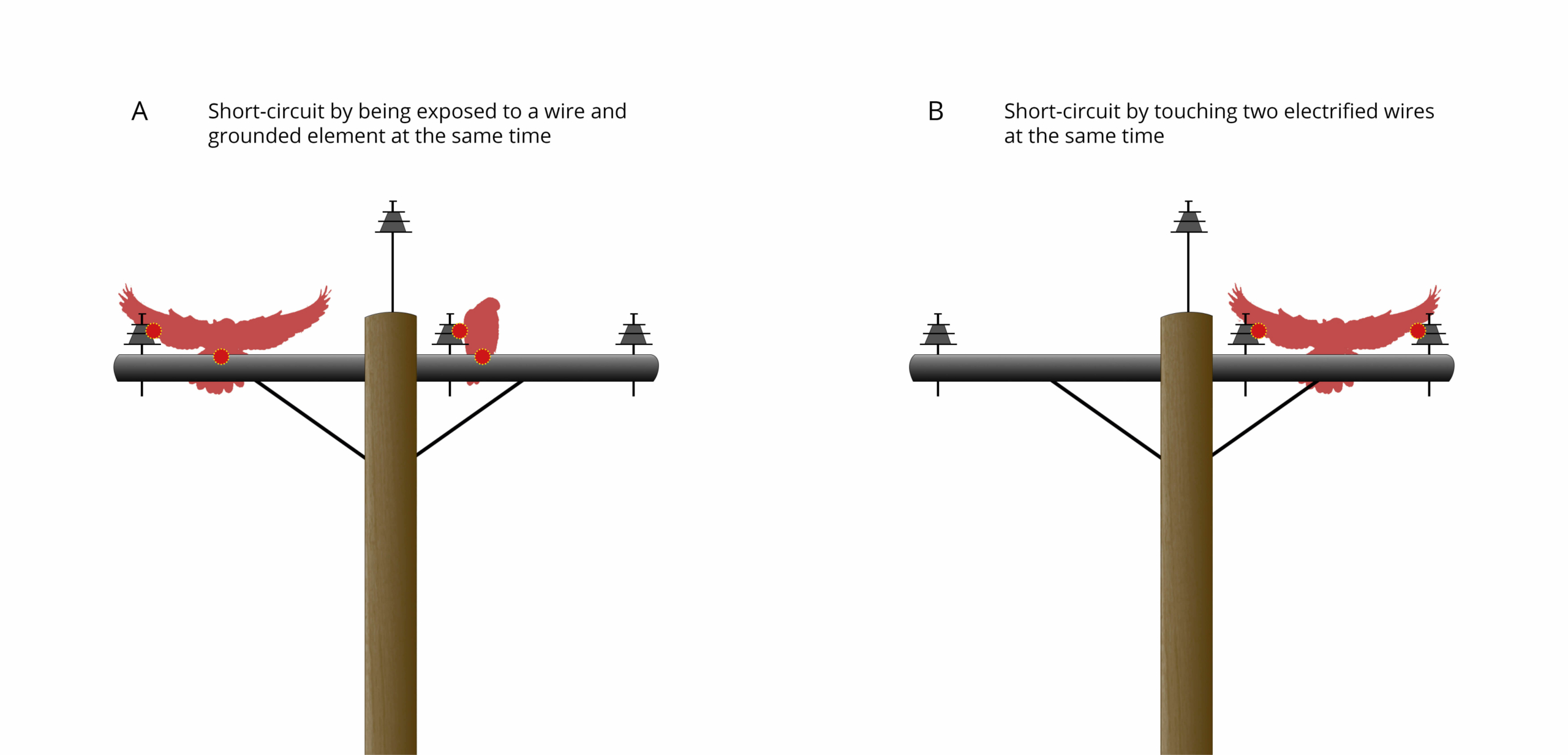
It is important to mention that electrocution due to bird droppings is also frequent, particularly for large bird species. Droppings are often quite long, making it possible to contact the conductor at a distance of over 1m, while the bird sits on the cross arm above the conductor. Droppings are rich in salts, which makes them a good conductor.
Bird species with high wing loading (e.g. pheasants and partridges) are more prone to suffering collisions with infrastructure rather than electrocution (Figure 5.10.5). Birds with long wingspans (e.g. storks and birds of prey) are generally observed to be at higher risk of electrocution, particularly from short-circuits in medium voltage lines. Over 70 species of birds of prey worldwide have been recorded as susceptible to electrocution, making this one of the most severely impacted groups of birds.
Due to the characteristics and distance between elements of medium voltage lines, electrocutions are most frequent at these installations. There are many different designs throughout ways along Europe and it is difficult to establish a general classification about the risk these lines pose. Safer powerlines are those that minimise the possibilities of contacting two risky points simultaneously. This is usually achieved by a combination of different elements: the cross arm configuration, the position of insulators, and the distance between elements.
Simply dealing with one of these elements to make it ‘safe’ is insufficient because an element considered safe on its own may become dangerous if other elements are not properly evaluated and vice versa. For example, horizontal cross arm configuration is considered safe, but when combined with sitting insulators it becomes highly dangerous (Figure 5.10.6). On the other hand, sitting insulators are considered to be high risk, but when implemented in a cross arm configuration impeding the perching of birds, e.g., using a ‘claw’ type configuration, they become safer (Figure 5.10.7). It is also important to evaluate the risk of a powerline in relation to the bird communities that inhabit the surrounding habitats, since the electrocution risk is also species specific.
Generally, poles and pylons with suspended insulators and horizontal cross arm configuration pose lower risks since the possibility of contacting the conductors is minimised. Other configurations, like alternated (or staggered) and vault cross arm configuration also pose a low risk of electrocution if safe separation between elements is provided (Figure 5.10.10).
However, this configuration still presents an electrocution risk due to bird defecation, mainly for large species like storks and eagles. To mitigate this impact, countries such as the Czech Republic have implemented another configuration that prevents birds from perching in risky places. At the same time, a horizontal perch under the console offers a safe place to land (Figure 5.10.7). In this case, siting insulators are not considered risky since the animal has no opportunity to perch on them.
Configurations of poles with jumpers below the insulators pose a medium risk of electrocution for birds, if sufficient separation between jumpers and insulators is provided (Figure 5.10.10). Lastly, high risk powerlines include sitting insulators – with the exception mentioned above – and complex constructions such as corner, tensioning or branch types, with several levels of cross arms, or those including additional risk points, such as transformers.
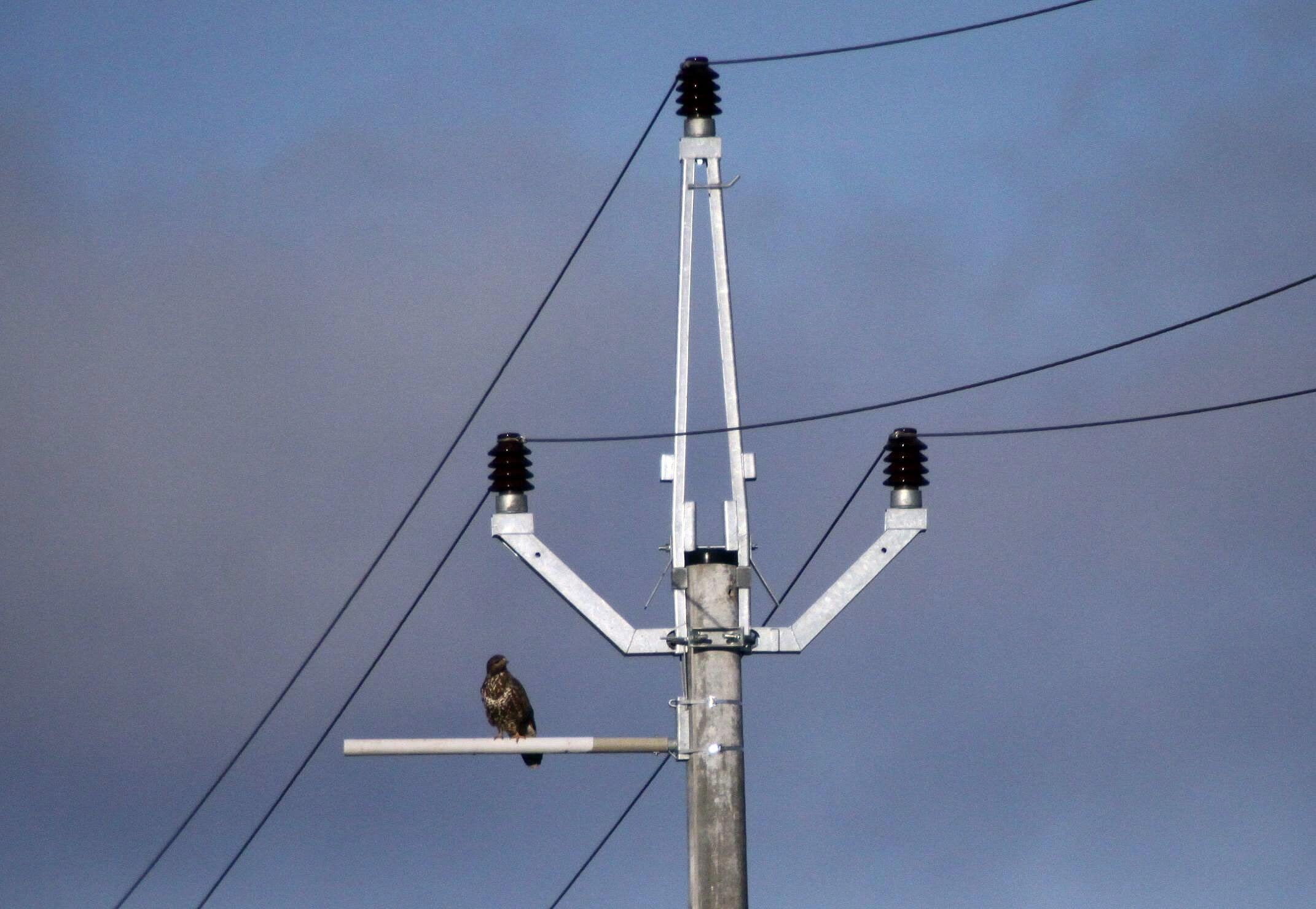
The use of inappropriate design on medium-voltage power pole installations has resulted in an enormous risk for numerous medium-sized and large bird species, which use these poles for perching, roosting and even as nesting sites (Figure 5.10.8). Many species of large birds suffer heavy losses and populations are decimated by electrocution, in some specific areas even to the point of local extinction due to this impact. Notable examples of this severe impact are in East Africa, where the population of Egyptian vultures (Neophron perncopterus) has declined as a result of the impact of powerline electrocutions, and the threatened Ludwig’s bustard (Neotis ludwigii), which is impacted by high-voltage transmission lines, with an annual mortality ranging between 4,000 – 11,900 individuals putting the entire population at risk of extinction.
Generally, it is easier to mitigate electrocution than collision risks. Strategies to avoid electrocutions are focused mainly on ‘separation’, ‘insulation’ and ‘redirection’ actions (Figure 5.10.9). Some of these, such as adding cable insulators, can be easily applied, even when the lines are electrified and without affecting the operation of the network. However, other retrofitting actions may require major works and even a temporary shutting down of the line.
Planning
When planning new powerlines or changing the management regime of the surrounding habitat, measures to be applied in order to reduce the risk of electrocution for birds include:
- Powerlines should not be located in areas with large concentrations of birds sensitive to electrocution, that can include Natura 2000 sites, Important Bird Areas (IBAs) and Special Protection Areas (SPAs). Any new installation needs to follow the requirements of EIA and also the actions established in the plans of protected areas.
- Electricity cables should be run underground, when possible, completely mitigating electrocution and also collision risks. The direct and cumulative effects of burying powerlines underground must also be considered. There can be long-term benefits in increasing the resilience of the infrastructure and contributing to climate change adaptation (see Section 5.9 – Adaptation of infrastructure to climate change: risk and opportunities for biodiversity) as above ground powerlines are vulnerable to extreme weather events such as strong winds. However, this measure is primarily an option for urban or peri-urban landscapes as land use changes in rural or agricultural areas are often an obstacle to be overcome.
- Natural perches should be left intact in surrounding habitats or if these must be removed, artificial perches should be provided so that birds of prey use these to roost and hunt instead of the power poles (more information on artificial perches is provided below).
Design
- The use of a hanging insulator and a horizontal cross arm design instead of sitting insulators and complex cross arm configurations help to avoid the risk of electrocution by contact (Figure 5.10.6), although they still pose a risk of electrocution as a result of bird droppings.
- Three main strategies to reduce the risk of electrocution ‘separation’, ‘insulation’ and ‘redirection’ are described below (Figure 5.10.9). However providing sufficient separation and insulation should always be prioritised.
Separation (Figure 5.10.9A): For configurations which pose an electrocution risk by contact, such as like alternated (or staggered) and vault crossarm and insulators with jumpers, sufficient separation (also referred as isolation) between energised phase conductors, and between phases and grounded wires accommodates at least the bird’s head-to-foot distance or wingspan. In the case of locations with regular wet weather, the distance should be enlarged to wing-span distance because wet feathers provide less insulation and higher susceptibility to electrocution. In general, the bigger the bird the more susceptible it is to electrocution.
Short distances between conductors often occur at switch towers, at junctions and at dead ends of the distribution system. The minimum safe distances between the different elements depend on the configuration of the crossarm (details in Figure 5.10.10), although some general recommendations are:
- A minimum distance of 150 cm between the conductors.
- A minimum of 100 cm in a vertical direction between a potential perch site and nearest energised part of the powerline. If this is not possible due to the crossarm configuration, at least a separation of 70 cm should be granted.
- A minimum of 100 cm in the horizontal plane. In regions with large species such as vultures, eagles or storks (which wingspan can reach up to 280 cm) and with a very damp weather, it should be increased to 150 cm.
Insulation (Figure 5.10.9B): If separation of the dangerous elements cannot be provided, exposed parts need to be covered or insulated, to reduce the risk of electrocution.
- When suspended insulators and vertical disconnectors cannot be provided, sitting (upright) insulators or horizontal disconnectors should be correctly covered. The length of insulated chains should be higher than 0.7 meters.
- In locations where electrocutions of birds of prey have been reported, the most dangerous lines should be replaced with aerial insulated cables forming a single bundle (Figure 5.10.11) without the need for other types of insulators. This measure has proved to be the most successful management strategy to safeguard the Spanish Imperial Eagle (Aquila adalberti) and is also recommended in Poland to avoid waterfowl collisions when low-voltage powerlines cross ponds.
- It is very important to correctly insulate transformer stations (terminal poles) and line junctions as they are one of the most dangerous design elements. A very effective solution in many situations is the installation of bird protection hoods.
- Appropriate maintenance is important to preserve the effectiveness of this measure in the long term, e.g., replacing lost insulation or corroded wires under the insulation in due time.
- New powerlines can incorporate the use of fiberglass and epoxy resin base poles and other elements. The greatest advantage of these structures is that there are no grounded elements near the wires, and that the distance between the wires meets the expectations, so the chance of electric shock is extremely small.
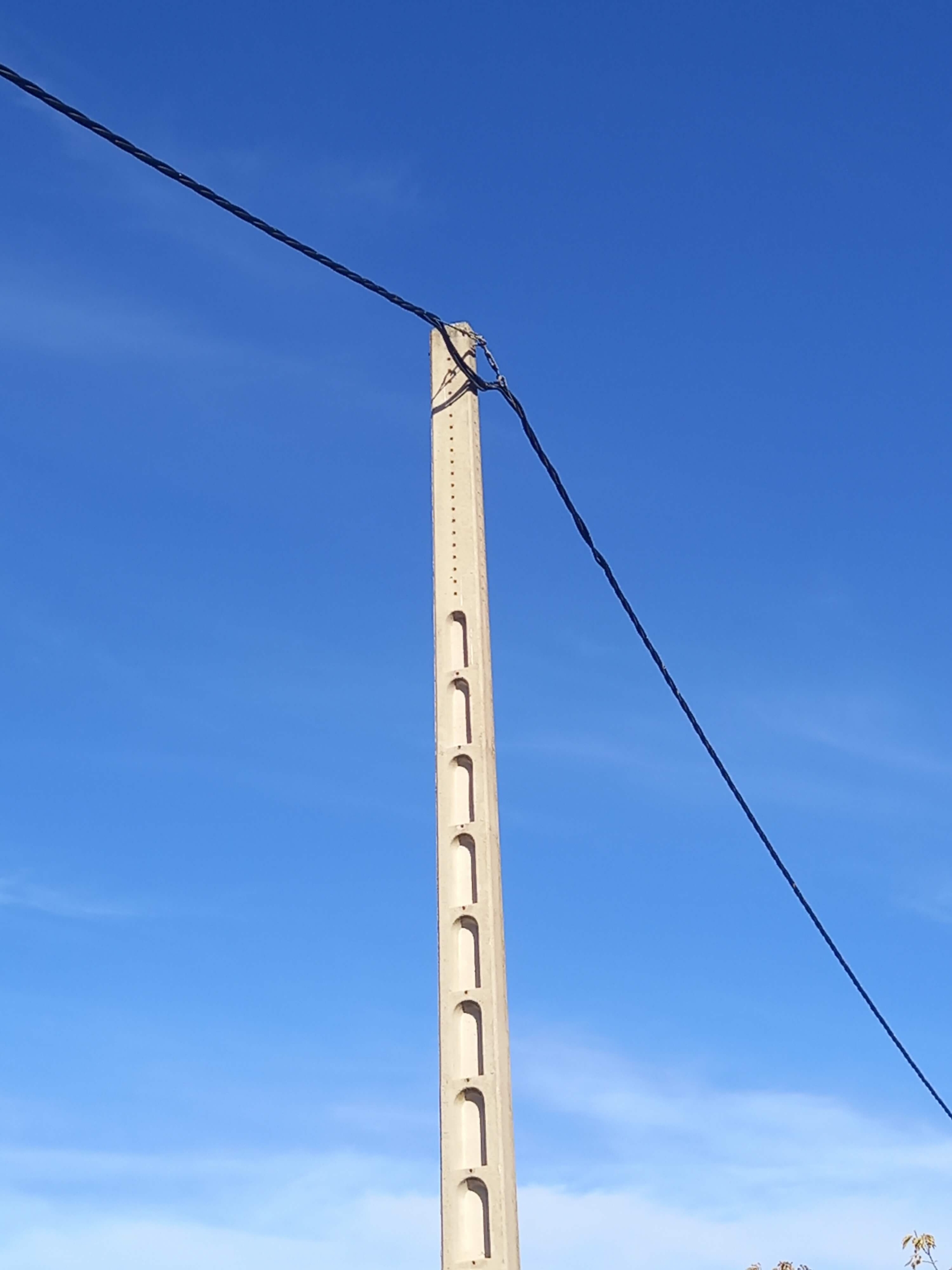
Redirection / Perch management techniques can be applied (Figure 5.10.9C), which aims to discourage birds from perching where they are close to energised lines, or by providing safe perches and nesting platforms on electricity poles. In general, this solution is less recommended as a mitigation measure than separation or insulation, because on some installations, birds remain at risk of accessing contact points (Figure 5.10.12A). However, there are other redirection techniques that can be as effective as the other approaches, e.g., a change in the shape of the cross arm that discourages birds from perching (Figure 5.10.7).
- Preventing perching usually involves installing exclusion devices or perch discouragers (Figures 5.10.12). Even though these techniques have been installed on many powerlines it has not been fully demonstrated that there is a significant reduction of electrocution risk.
- Providing alternative, artificial bird-safe platforms, for nesting particularly, is an effective measure proven to reduce electrocution risks (Figure 5.10.13). These platforms must be placed at a safe distance from the energised parts of the powerline.
Points for special attention
Retrofitting existing powerlines to mitigate electrocution risks can result in the following errors to be avoided:
- Inappropriate product design such as protectors that don’t fully cover the energized components of the line, can undermine effectiveness (Figure 5.10.14). This also includes situations in which inadequate products cannot be secured correctly on the electrical installation, such as covers to protect specific energised elements which fall off or are easily dislodged.
- Mitigation errors when some protective components are correctly retrofitted, but others are not, resulting in a lack of mitigation.
- Application errors when the appropriate insulation and protection materials have been selected but are not properly installed, leaving some energised spaces or parts unprotected.
Habitat modification. Habitats surrounding powerlines can be modified and/or managed in order to change how attractive these are for birds (see Section 5.7.1 – Verges and other green areas). These habitat modification actions need to be carried out on a large scale to achieve changes in bird population movements successfully.
Avoiding and reducing collisions of flying fauna with powerlines
Poles, powerline cabling and other parts of the electricity transmission network are often difficult to perceive as obstacles for birds, resulting in collisions. In most cases colliding with a cable is fatal due to severe injuries. Bird collision with powerlines is a widespread problem requiring mitigation measures, especially in zones where large aggregations of birds are common (e.g., when powerlines cross wetlands, steppe habitats or in general, sites included in Natura 2000 network).
Biological, ecological, and geographical aspects related to bird collisions can be assessed in different steps in order to prioritise where a new powerline should be constructed elsewhere. The following steps should be considered when planning / designing a new powerline:
- Avoid planning powerlines across areas designated as Natura 2000, Important Bird Areas (IBAs) or Special Protection Areas (SPAs).
- If impossible to avoid these areas, identifying which species could be affected by the powerline, producing information on species-specific vulnerability (which includes migratory birds versus stationary species) and define appropriate mitigation measures is essential.
- Assess if planned powerlines will intersect with daily movements of birds to feed, and roost or be traversed by long-distance migration routes. Collisions usually affect migratory birds, also those migrating by night.
- Determine critical biological and ecological factors that can create bird collisions, including species’ vision capabilities, body size and shape and life cycle behaviour.
- The implications that potential mortality caused by bird collisions will have for species at population level.
In order to understand why some bird species are more at risk of collisions than others, several key aspects should be considered, such as:
- The species-related body structure / wing-ratio, which determines how the bird flies (Figure 5.10.5).
- The ecology/biology of the species, especially if the species is nocturnal or diurnal, active or inactive in low-light conditions.
- The topography and the habitat types around the powerlines.
- Temporary adverse weather conditions, such as fog or low visibility weather phenomena that can limit the vision capability of birds.
- The powerline category and design.
Vulnerability to collisions with powerlines depends on several factors. One of them is flight ability, which is determined by body size and wing proportions, which together define the wing loading. This parameter can define ‘poor fliers’, like water birds and large steppe birds, which are more vulnerable to collisions. Also, species with flocking behaviours are vulnerable to collisions.
In general, the risk of colliding with powerlines is generally associated with high voltage transmission powerlines, and in particular against the ground wires (also known as earth wires or shield wires), which are the highest cables on these type of powerlines (Figure 5.10.15). Conductor cables are generally more visible to birds, but when they try to fly over these, the birds tend to collide with the ground wires above, which are thinner and less visible. High-voltage powerlines are taller and usually birds are flying faster, with less time to react, at these heights than if they would be closer to the ground. Most of the collisions also tend to happen at night or in low-visibility conditions (e.g., in adverse weather conditions), when the obstacles are even less visible to birds.
Collision accidents are more frequent among migratory birds, and/or gregarious birds which flock together when feeding or breeding. Generally, the most affected species are cranes, waterfowl, storks, bustards, but also wintering birds which form large flocks (e.g., passerines, lapwings, etc.).
Mortality hotspots along powerlines can be identified through monitoring of mortality, using methods such as Bird Strike Indicators that automatically register the number of collisions or trained sniffer dogs which can locate dead birds.
Planning
- Powerlines should not be planned in areas relevant for birds, especially across migratory routes (especially in the case of nocturnal migrant species), nesting or feeding sites.
- When possible, plan to bury new cabling underground to avoid negative impacts of powerlines on wildlife and landscape.
- In forested areas, it is recommended that the height of the powerline is kept lower than the height of the canopy. This will reduce collision risk since bird flight is maintained higher than avoiding collisions with the wires of the powerlines below (Figure 5.10.16). This can also be achieved by planting trees, which itself brings additional benefits to biodiversity, provided these do not interfere with the functioning of the powerline (see Section 5.7.1 – Verges and other green areas).
- Reduce and modify human access points in order to decrease disturbance to birds which congregate near powerlines, reducing collisions caused by frightening and flushing birds into jeopardy towards the lines.
- Planting trees at the edge of the powerlines to force birds to fly above the height of the nearby lines is a measure that it is only viable to cover distribution lines or lower conduct wires high-voltage pylons and wires, which are the most problematic for birds, cannot be covered by trees as they are too tall (usually between 20 – 70 meters high, or taller)
- When planning new powerlines, making use of the natural topography may provide an effective risk reduction. Differences in the levels of terrain can be used to install powerlines in a way that does not place them in the flying trajectory of birds (Figure 5.10.17).
Design
There are several design recommendations for electric cabling, poles and overall powerline structures which make the infrastructure less dangerous for flying fauna. The approaches can be summarised as design of the lines – mostly applicable to new infrastructure -, installation of visual markers, and other solutions.
Measures concerning cable and pole design:
- In general, in order to reduce and avoid bird collisions, the use of lower powerlines is preferable to higher ones. The use of shorter poles means they are less obstructive, and birds can distinguish them more easily.
- Minimize or flatten the potential collision area by fixing cabling to as few different levels as possible or, optimally. to just one level.
- Install, when possible, larger diameter cabling, as this may make the lines more visible to flying fauna.
- Bundle low-voltage powerlines into one cable.
- Use the lowest pylons/poles possible for safety and technical reasons. Minimize the distance between poles, so that birds fly less between them.
- Removing the ground wire (also known as the shield or earth wire) from transmission structures can reduce bird collisions. This is often not possible as these wires are very frequently used to protect powerlines from lightning strikes.
- For new construction or when a line is being rebuilt, changing the line configuration (e.g., changing wire diameter, using spacers to increase visibility, lowering the height of the lines, decreasing span length, bundling wires, etc.) could help minimize collisions.
Measures concerning the installation of visual markers and lighting / illumination of lines:
- The risk of collision with a specific powerline installation depends on several aspects, like the design and features of the lines, the species of birds, the landscape and habitats in the surroundings. Because of this, it is generally difficult to obtain representative data on the effectiveness of the different markers. At the same time, scientific and methodologically well-proven studies on diverters are scarce. New research is required to improve knowledge about effectiveness of the measures.
- Providing lighting for powerlines during the hours of darkness could be an option to reduce collision at night which is not suitable in natural areas due to increase of light pollution. This lighting can be achieved by illuminating the cables with UV light and the pylons with red or white light. This is especially useful for nocturnal migrant species and in places where flocks of birds may rest around powerlines and can suddenly take flight due to disturbance, e.g., by passing trains. This measure could be also considered in areas which have frequently low visibility e.g. due to fog or other inclement weather. High-contrast combinations of dark- and light-coloured reflective materials and glow-in-the-dark highlights mounted on dark background materials can be applied.
- Installing visual markers on the hanging electric wires to increase their visibility (spirals, balls, bird flappers) can be a useful measure to reduce the risk of collisions of high voltage powerlines under operation. There are different types of line marking, which aim to make cabling as visible as possible, giving flying fauna enough time to perceive the cable and correct their trajectory before a fatal collision. The main types of line marking are aerial spheres, spirals, and suspended devices. In general, one the most important aspects of the markers is their size. Most recent studies also seem to indicate that ‘active’ markers (with moving elements) are more effective. The importance of other aspects on the efficiency of markers, such as their colour and shape, in their efficiency is under scrutiny and needs further research. Besides these types of marking, larger diameter wires also improve the visibility of the cabling for flying fauna.
- Most collisions reported happen either at the ground wire (also known as shield wire or earth wire) or at the phase conductor and neutral wire on distribution powerlines. Therefore, a majority of the marking devices are installed on these parts of the powerline structure.
- When powerlines are bisecting bodies of water, such as lakes, line visual markers can be a way to reduce the risk of bird collisions.
- A study concluded that any sufficiently large line marking device that thickens the appearance of the line for at least 20 cm in length and placed at least every 5 to 10 metres is likely to lower collision rates by 50% to 80%.
- Some electricity utility companies recommend marking only 60% of a span, the central portion of the ground wires on transmission lines, as they point out this is where most of the flying fauna collisions occur (Figure 5.10.18).
Main types of powerlines marking devices are described below (Figure 5.10.19):
- Aerial marker spheres (aviation balls) (Figure 5.10.19A). They consist of large, coloured balls, usually attached to distribution phase conductors or transmission ground wires, which are used both to warn aircraft and reduce bird collisions. To mitigate bird collisions, their diameter sizes often range between 23cm – 30,5cm, depending on local conditions. The recommended spacing between spheres varies from 30 to 100m. They are available in a diversity of colours such as orange, white, yellow, red, etc. Yellow is the colour which has been shown to be the most useful to avoid bird collisions, as it reflects better in low light conditions, such as at dawn or dusk.
- Spirals. There are many different types of spirals (Figure 5.10.19B), some of which were designed to reduce line vibration, but were then found to increase visibility of the cabling. Others are aimed at diverting bird flight, such as the Bird-Flight™ Diverter (BFD) or the Swan-FlightTM Diverter (SFD). Their size ranges from 3.8 to 30 cm in diameter and 10 to 100 cm in length. The efficiency of the smaller spirals is still being assessed by scientific studies and more research is needed. Spacing between these devices ranges from 5 to 15 m depending on their size. The most common colours for the spirals are yellow or combinations of yellow and grey, white and red.
- Suspended devices. These kinds of devices are attached to the cable with a clamp, so they can move with the wind (Figure 5.10.19C-D). Recent studies indicate that these devices may be more effective. There are several kinds which move in different ways (e.g., they spin, swing or flap). They come in different colours, and some of them have reflective and glow-in-the-dark properties. They can be attached to distribution phase conductors of up to 40 kV and to ground wires up to a diameter of 1.9 cm.
